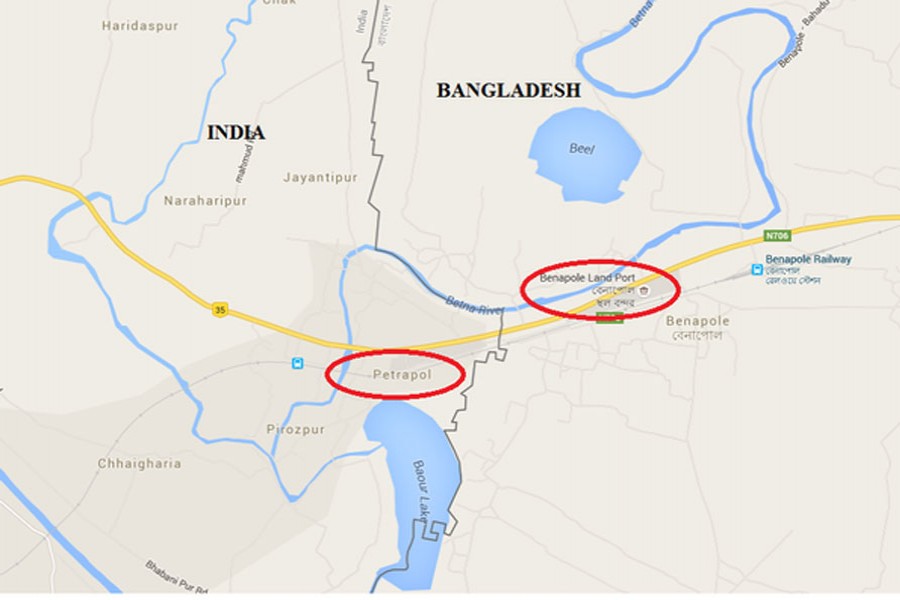The latest meeting of the Bangladesh-India Joint-Working Group (JWG) on Trade concluded last week in Dhaka without making any concrete progress.
Both sides agreed to address various Non-Tariff Measures (NTMs) and remove different trade barriers. Records, however, show that these issues ritualistically feature on the agenda of all bilateral meetings between the two countries and commitments are made to address them. But nothing actually happens. The just-concluded meeting was also no exception.
In fact, barriers to bilateral trade between the two neighbours are well identified. But a sincere attempt or meaningful move to remove or even reduce them is yet to be made. That's the reason why they emerge on the agenda repeatedly. Bangladesh, which bears the brunt of trade-impeding barriers most, has no choice other than pressing for their removal.
One of the major barriers to increase the volume of bilateral trade is poor infrastructure at the land customs stations of both the countries. Even the connecting roads are not always smooth. While the situation is known to all, both the governments are sometime not convinced that investment on these land ports or land customs stations will pay off.
In fact, the governments think that building permanent physical infrastructure is expensive and it also involves regular maintenance cost. But revenue generated through the trade activities is very low or insufficient to bear the costs. So, they prefer operating the ports or stations with ad-hoc arrangements.
Lack of adequate manpower is another big problem, especially for the small land ports and customs stations. With limited number of manpower, it becomes difficult for the customs officials to do their work with efficiency. Absence of basic amenities near the border points sometime turn terrible for officials and traders. The officials and port operators have to travel a long way to reach a port or customs station. Unreliable postal service also makes things worse as necessary documents don't reach in time.
Businesses are of the opinion that better infrastructure will facilitate increase of the flow of trade. They demand deployment of sufficient manpower to run the operation of the ports smoothly. They also argue that with all the facilities, traders will be interested to trade through the dedicated border points and volume of trade will eventually increase.
In a submission to the government before the JWG meeting, the Federation of Bangladesh Chambers of Commerce and Industry (FBCCI) argued that lack of adequate customs and port is a hindrance to the expansion of Bangladesh-India bilateral trade. It said that limited logistics, lack of warehouse facilities, narrow and poor condition of roads in most of the land ports, both in India and Bangladesh, and the absence of testing facilities at any Indian land port bordering Bangladesh are the major problems that need to be addressed.
"Bangladesh's trade with India could increase significantly provided the constraints on land ports infrastructure of both countries are addressed," the apex trade body observed. "Immediate improvement is required in infrastructure and more banking services at the land ports along the Bangladesh-India border to facilitate trade between the countries," it added. FBCCI called for building modern warehouses, testing facilities, connecting roads and automated system to increase capacity of the land ports for boosting trade.
As 70 per cent of Bangladesh-India trade is conducted through Benapole-Petrapole land ports, both the governments invested adequately there. The all-time integrated check post has also been introduced to facilitate faster movement of goods-laden trucks. Nevertheless, both sides of the border still have some shortcomings like inadequate shades. Thus, with growing trade, demand for facilities also grows.
While Benapole, the largest land port of the country, is well-equipped with logistics despite some limitations, the situation in the smaller land ports are usually the opposite. So, in the JWG meeting 'both the sides decided to expedite the process of improving infrastructures at land customs stations.'
One reason for low volume of trade through most of the land ports and land customs stations is restriction of items for import and export through particular land ports or land customs stations. FBCCI mentioned this as one of the major trade barriers between the two countries and said that the restrictions were generally trade restrictive and imposed mostly due to lack of infrastructure across the borders.
The apex trade body was of the view that due to this undesirable barrier, both the countries couldn't fully liberalise import and export of all traded products through all the land customs stations (LCSs). FBCCI pointed out that Benapole land port has came under huge pressure, the businessmen often do not get prompt services and also face harassment. One remedy of the problem may be the full activation of Sonamajjid, Bhomra, Burimari, Akhaura, Tamabil and Sheola land ports. By fully activating these ports, pressure on Benapole land port may be reduced.
Another major problem in the bilateral trade is the rise of NTMs and some of which appear as Non-Tariff Barriers (NTBs). India argues that certain NTM has been introduced to ensure quality or standard, while Bangladesh's point is that some of the NTMs are trade restrictive as these are imposed on selective basis.
In fact, NTM is a tricky issue and sometimes it is difficult to deal with it. Acknowledging the problem, countries in South Asia agreed to set up dedicated NTM Desks in their respective apex trade bodies. This is one of the methods to deal with the NTMs and was moved by the SAARC Chamber. The coverage of NTMs is very wide and it requires comprehensive understanding to deal with them properly.
Inadequate infrastructure and lack of logistics facilities are also responsible for some of the NTBs. Absence of testing laboratories near the Indian land ports is an apt example. While requirement of testing is a valid NTM, the time-consuming process of testing not only increases the time and cost of trade, but also turns it into a NTB. Removal of such NTBs is critical for the future expansion of bilateral trade.


